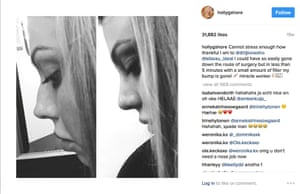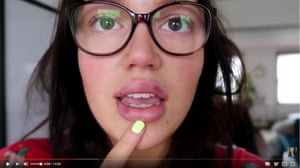Claudia Wright has filler injected into her lips every two months to plump them out, and is having them done again in two weeks. “I want them to look big,” she says. She likes them best the day after the procedure, when they are still swollen. When they settle – lip enhancements are supposed to last up to 18 months – it makes her want to book another appointment.
Wright, who is 24, is open about the procedure on her beauty blog and Instagram account. “I like the fake look,” she says. “I’ve got bleached blond hair, I have long eyelashes. I like that look, I’m not trying to look natural. I’m so open about everything I’ve had done, I don’t think it’s an issue.”
She started having lip enhancements when she was 21. Her mum, she says, recently told her that her top lip looked like a rubber dinghy “and that if I carry on getting it done no one will take me seriously. She’s really against them.” But women her own age have told her they love them and ask where she gets them done. “If anything, I’m getting a little bit more each time I go now because I want them to look more full. I did want just a full top lip but now I want both of them looking really full.”
The British Association of Aesthetic Plastic Surgeons (Baaps) recently released its annual figures showing a 40% drop in the number of cosmetic surgery procedures performed by its members, the lowest for nearly a decade. After years of steady rises, it came as a bit of a surprise. The economy and job insecurity was blamed – cosmetic surgery is expensive, after all.
The truth – says former president Rajiv Grover, who compiles the annual audit– is a bit more nuanced. Baaps only represents about 40% of cosmetic surgeons and he suspects that, with the wealth of information online (including many dedicated cosmetic surgery forums), people are researching experts and choosing a specialist, rather than a general cosmetic surgeon. They are going to a breast surgeon for breast augmentation or an ear, nose and throat surgeon for a nose job – surgeons who practise a bit of cosmetic surgery on the side, but aren’t members of Baaps, and so don’t get included in the figures.
But he accepts there may be a drop in surgery overall (if not by 40%). Surgeons are reporting a reduction in the number of procedures a patient has at one time. Before, he says, someone might come “to have some liposuction of saddlebags, as well as having some skin removed from their lower tummy and maybe some breast surgery, [but] now they’re just having one of those things done. That’s where I think uncertainty in the economy will have come into it.” Crucially, though, he says, “there is a rise in what you can have done without surgery. If people don’t have the time to spend two weeks off work recovering from a facelift and want a little bit of improvement, they can have whatever is on offer without downtime.”
The sheer number of non-surgical procedures is dizzying, and ever-growing. Botox is now so well established that it celebrates its 15th anniversary as an FDA-approved cosmetic treatment this month, but you can also have your face lasered and peels applied to improve skin texture, and ultrasound therapies to tighten. You can have tiny threads, that gradually absorb into the body, put in your face during your lunch break to hoick it up, and filler put into your cheeks. Soon, people will be able to have fat-melting injections for their double chins. At-home treatments are also increasing – you can get home laser hair removal and microneedling devices (rollers with tiny spikes that prick the skin and are supposed to encourage collagen production). One DIY trend that emerged last year was dermaplaning – using a scalpel to shave a layer of skin cells and hair, from the face for a supersmooth, airbrushed effect.
“A significant proportion [of patients] say they’ve come to me because they don’t want surgery yet or they want to try to prevent it from happening at all,” says Dr Frances Prenna Jones, whose clinic in Mayfair offers a wide range of treatments. “Twenty years ago your only option was surgery – now there are machines, injectables and so much more you can do. A lot of the time, it is replacing the need to have surgery done.”
Machines using lasers or LEDs “work deeper down within the muscle to make new collagen and elastin to give that nice infrastructure, and tightening effect”. Previously, loose skin was cut away and tightened. Now it is plumped up with injectable filler. Volume replacement is what has really changed in the last few years, says Prenna Jones. “Even three years ago, people would say, ‘I am not having filler, there’s no way.’ Now that people understand what it really means – that you don’t have to have puffed-up lips or puffed-up cheekbones. When I look at the amount of filler I was doing three years ago and the amount I’m doing now, that’s definitely on the rise.”
The cost of the treatments hasn’t come down spectacularly, so she doesn’t think that is driving popularity; it’s more the fact it is becoming normalised. “Now I think women accept that it is part of their monthly budget, the same as doing their hair.”
The use of more intense beauty treatments – such as teeth whitening and HD brows, where eyebrows are dyed, waxed and shaped – has accelerated in the past few years. “It is becoming increasingly normalised to have more done [to meet] what we think of as quite basic beauty standards,” says Heather Widdows, professor of global ethics at the University of Birmingham and author of the forthcoming book Perfect Me. “It doesn’t feel like a big hurdle to go from getting your hair done to Shellac-ing your nails to Botoxing.” There is less stigma, she says. “I think Botox, to use one example, is now being seen as routine maintenance, and that’s a very different scenario from 10 years ago.”

What is driving the change can’t be attributed to one thing, she says. “We live in a more virtual and visual culture. We look at images differently, we have HD and computer technology that means we see flaws in skin we didn’t see before. And more people we know have had non-surgical procedures.”
Surveys about body image, she says, routinely show an epidemic of unhappiness about appearance. The rise of more “normal” women (ie, not supermodels) who become YouTube and Instagram stars should, in theory, mean wider and more democratic standards for beauty, but in reality it is their “normalness” that has changed the idea of what normal is, particularly when it is accompanied by heavy makeup and invasive procedures. “It puts pressure on all women to feel they have to look like that,” says Widdows.
What is striking, says the Guardian’s beauty writer Sali Hughes, is the number of much younger women seeking to alter their face. Contouring makeup, where different shades “shape” the face, is “predominantly a young woman’s trend and it’s fuelled by celebrities, but the celebrities who fuel it as a trend also have surgery and non-surgical procedures, so it’s a triple-pronged attack. It just so happens that young women can only afford the contouring part. It really exists to look good in pictures.” But the more disturbing thing, she says, is how many young people want, or are having, non-surgical procedures. She recently met an 18-year-old at an event who told her all her friends want fillers and lips like Kylie Jenner (the youngest of the Kardashians, who had lip-filler injections) for their birthdays. “They want their parents to pay for fillers for them.”
The aim, she says, is not to look natural. “They’re mimicking a surgical look or at least a heavily injected look that celebrities wear. I think young people are much less interested in pretending that this is what nature gave them than we perhaps assume. Where you would once hear actors in their 40s and 50s completely denying non-surgical procedures, and I quite understand why, even though I don’t think they should, young people don’t have that anxiety about non-surgical.”
Dr Tijion Esho, founder of the Esho clinics in London and Newcastle, says there has been a culture change. “One big thing now is people start earlier,” he says. Before, people would not consider these treatments until they were in their mid-40s. “Now women in their mid-20s are very aware of the ageing process and are already doing things to halt it early. The non-surgical treatments are improving more and more. It doesn’t mean non-surgical will ever replace the knife – there is a limitation to what non-surgical can do – but, in many areas, people can get improvements that are satisfactory.”
Fillers have changed everything, Esho says. He can use fillers to improve the shape of someone’s nose – a cheaper, less permanent version of a nose job without the need for general anaesthetic – for instance. In February one patient, Holly Hagan, the 24-year-old star of the reality series Geordie Shore, posted pictures on Instagram of some filler she had to change the shape of her nose and chin.

‘When we’re doing fillers in young people we have to be very careful, from an ethical standpoint,” he says. “Legally, it does concern me because there is no law to say what age someone has to be to undergo fillers. Someone could treat a 16-year-old, but ethically that is wrong.” The non-surgical industry is unregulated and anyone can set themselves up as a practitioner with no training. Botox is prescription-only and people should be seen by a prescriber – a doctor, dentist, nurse or pharmacist – but that doesn’t always happen, which is why beauty therapists can offer it cheaply in salons.
Has the look that young patients are after changed? There is a growing minority, Esho says, “where there is an evolution in what we perceive as beauty”. Some bring in Instagram pictures where they have been heavily filtered, and skin and faces are flawless, and say they want to look like that. “It has almost gone full circle. Initially, when surgery and non-surgical aesthetics were available, it was the treatment of the rich. It was a statement to have it done so people wanted to let you know. Then there was a transition where people didn’t want others to know, it became more natural, understated. Now, it has gone back, but because now the services are more accessible, it’s more obvious. And social media has made it more noticeable.” His most popular treatment is providing lip filler, which accounts for about 70% of his work.
On YouTube, you can find numerous videos of vloggers who have posted about their lip fillers. Gabriella Lindley, a beauty vlogger, has had more than 360,000 views of hers; another video she put up, entitled “My Lip Filler NIGHTMARE” in which she talks about how her lips went lumpy, has had more than 314,000 views.

Jessica Balkay, 22, researched lip fillers on YouTube before getting her lips done for the first time. “I wanted to get it done as I just didn’t like the shape of the sides of my lips and wanted a fuller top lip.” She said it has made her “really happy. I love makeup and taking selfies and having my lips looking fuller just made me feel happier with my appearance.”
She is planning to have a few more injections to build up the size and shape, then plans to go every six months for top-ups. “I think in my generation it is becoming a lot more normalised to have non-surgical procedures,” she says. “I don’t see the issue with that as long as people research reputable places and are doing it for themselves, not to please others. I don’t want to look like anyone else but myself, but I want to be a prettier version of myself.”
Where will it end? Widdows sighs. She thinks the use of non-surgical, but still invasive, procedures are likely to become commonplace. “Doing nothing gets harder and we have to wait and see whether Botox becomes ‘required’, like [people consider] visible body-hair removal or hair dyeing. That’s the way it’s moving.”
Hughes is a bit more optimistic, particularly where much younger women are concerned. “The only glimmer of light in the whole sorry picture is that at least non-surgical procedures are not lasting, so one hopes that young people outgrow them in the same way that I outgrew lightning bolts drawn down my face.”
The rise of non-surgical beauty: ‘My mum said my lip looked like a rubber dinghy’
Hiç yorum yok:
Yorum Gönder